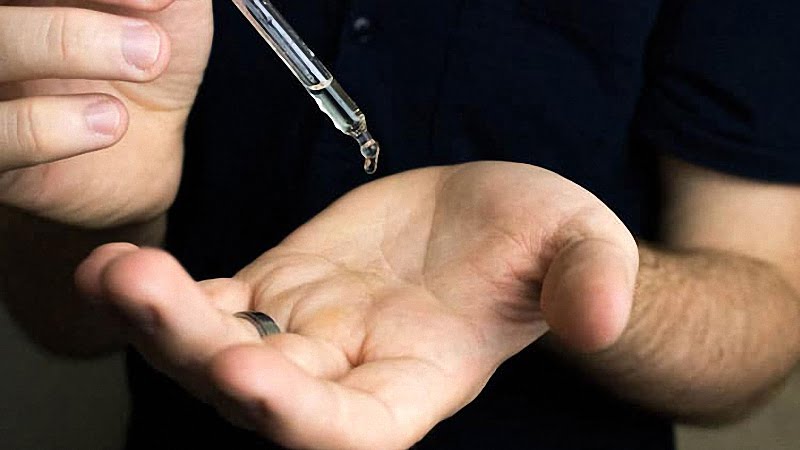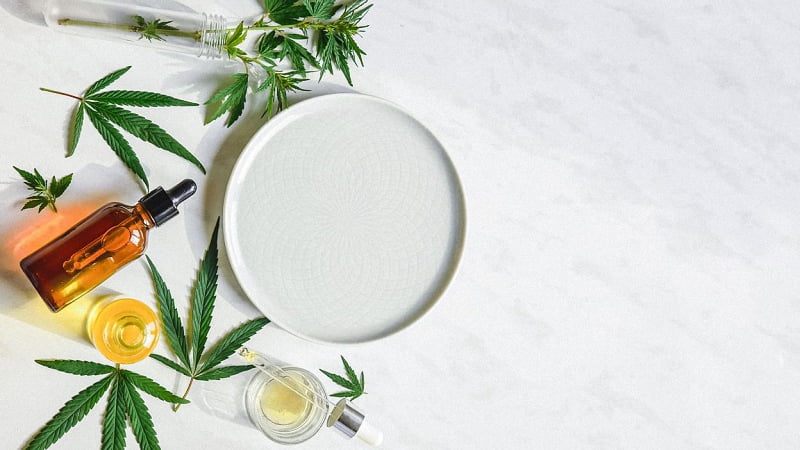CBD Oil for Tendonitis: Benefits & Usage

The reason why CBD has become so popular in recent years is due to its remarkable painkilling and anti-inflammatory properties. Anecdotal reports from CBD users as well as numerous scientific studies have mentioned these qualities, touting CBD for its effectiveness without the dangerous side effects associated with conventional painkillers, especially prescription ones.
The BD boom has given rise to a plethora of different products formulated to ease different types of physical discomfort. Even sports people and professional athletes use it to relieve pain, including tendonitis. This painful ailment manifests as inflammation in tendons, which control almost every movement in the human body — even blinking of your eyelids.
The exploitation of any muscles can lead to tendonitis, so the biggest risk factor here is intense physical activity such as professional sports or heavy-duty jobs such as construction works or mining. Tendonitis is more likely to happen when people get older and can also derive from pre-existing health conditions such as diabetes or arthritis.
Today, we explain everything you need to know about tendonitis and whether or not CBD oil can help treat this ailment.
Let’s start with a brief overview of tendonitis and its types.
What Is Tendonitis?

Tendonitis is a physical condition that occurs when the tendons, which are the tissues connecting the bone with the muscle, suffer from inflammation. Tendonitis is a common sports injury, where a part of the body containing tendons is overloaded or overworked.
When it comes to overload, physicians usually mean a sudden increase in speed. For example, let’s say you start running at high speed immediately after walking steadily for a while. Repeated overload of tendons can lead to the Achilles tendon, where the tissue found at the back of the lower leg gets swollen.
Overwork means that the frequent repetition of certain movements, such as weight lifting, can have a negative impact on the tendons in general — especially those in arms or legs.
Other causes of tendonitis include infections, deformities, or other medical conditions, such as Haglund’s deformity, gonorrhea, and diabetes.
Types of Tendonitis
Tendonitis has several different forms depending on the parts of the body it affects. It can show up in the shoulder, elbow, wrist, knee, and heel.
Here are the most common types of tendonitis:
- Tennis elbow – tennis elbow is caused by inflammation in the tendons on the outer side of the elbow. Pain may begin in the forearm and surge to the wrist and fingers. As the name suggests, this type of tendonitis is common among tennis players, but it can also affect plumbers, construction workers, painters, and artists who constantly move their arms.
- Achilles tendonitis – this type of tendonitis occurs in the largest tendon in the body known as the Achilles tendon. When the tissue connecting the heel with the calf muscle gets exposed to overwork, it causes swelling and pain. Runners are the most exposed group to this condition, but Achilles tendonitis may also affect people who have a sudden increase in pace during running activities.
- Rotator cuff tendonitis – also referred to as bicep tendonitis, this ailment involves shoulder pain caused by inflammation of the biceps tendon. People who have rotator cuff tendonitis often report pain running from the shoulder blades to the upper arm. This type of tendonitis may be triggered by frequent stretching of the arms or by heavy lifting. The condition may cause patients to experience problems falling asleep or reaching objects and surfaces located above the head and behind the back.
- Golfer’s elbow – golfer’s elbow is caused by the inflammation of the forearm, where the swelling appears inside of the forearm and elbow. The condition can be triggered by a wide range of activities that use repetitive hand movements, such as throwing, gripping, swinging, and flexing.
Does CBD Help with Tendonitis?
Most people can successfully treat tendonitis with OTC painkillers, such as ibuprofen, naproxen, and aspirin — it rarely requires the intervention of prescription medications.
Despite being effective at treating minor pains, combining too many non-steroidal anti-inflammatory drugs (NSAIDs) can result in dangerous side effects, such as gastrointestinal bleeding or heart attack — not to mention that they lose effectiveness over time (1).
Severe cases of tendonitis are also treated with corticosteroid drugs. These painkillers are used for pain management; doctors apply them to athletes using injections for immediate relief from inflammation and pain.
Now, corticosteroids are stronger painkillers than NSAIDs. Unfortunately, their chronic use may weaken the tendons, impairing their functioning and causing even greater damage (2).
For the above reasons, people have started to seek out natural, safer alternative treatments for tendonitis.
Numerous studies have pointed to CBD as potent anti-inflammatory properties. For example, one study has found that CBD can effectively help people manage arthritis pain, which affects the connective tissues like ligaments and tendons (3).
Another study has concluded that CBD oil has anti-inflammatory and immunomodulatory properties for rheumatoid conditions (4). The study has also stressed the low efficacy of traditional prescription painkillers. Drugs like opioids can even lead to uncontrolled rheumatic pain and worsen inflammation, which is the underlying cause of arthritis.
Researchers have discovered that CBD produces more potent effects for inflammation and pain when taken in combination with THC, the second major cannabinoid in the cannabis plant.
CBD and THC are comparable to opioids in terms of the anti-inflammatory and painkilling benefits, but they don’t cause adverse side effects and can’t lead to a fatal overdose because they don’t target the brainstem area responsible for respiratory function.
In 2020, CBD was approved for athletes by the World Anti-Doping Agency (WADA). The organization applied those changes in its updated World anti-Doping Code.
Benefits of CBD Oil for Tendonitis

As said earlier, tendonitis involves swelling and pain in the tendons. Symptoms may last for anywhere between several days to a few weeks, depending on the severity of the injury. People usually recover from tendonitis within two days to six weeks.
Tendonitis can transform into tendinosis if left ignored; this condition involves severe tendon degeneration involving joint stiffness, chronic pain, and movement restrictions.
Tendinosis occurs when tendons lose too much collagen due to overwork while not being completely regenerated. Collagen is the most abundant protein in the human body; it’s responsible for the strength, structure, and elasticity of the skin and bones.
Tendinosis is more challenging to treat than tendonitis — usually taking around three to six months. Treatments include stretching, massaging, shockwave therapy, or surgery.
People with severe tendinosis may wear temporary slings, splints, or braces on affected areas. Sometimes, surgery is necessary to realign and repair tendons when the damage is too heavy.
Below we provide evidence supporting CBD’s ability to treat tendonitis and its symptoms.
CBD Reduces Inflammation
Plant-based cannabinoids such as CBD can regulate the immune system’s reaction to inflammation.
Inflammation is a natural process that occurs when the body gets injured or when a person ingests harmful substances.
CBD has a remarkable anti-inflammatory effect. When CBD starts interacting with the endocannabinoid system, it causes the macrophages to inhibit the release of cytokines.
Cytokines are pro-inflammatory proteins, while macrophages are white blood cells that react to infections.
A study performed on rats showed that oral forms of CBD taken in subsequently higher doses has helped reduce inflammation on the subjects’ paws. The paws were also less swollen after a few hours of administering CBD for the first time (5).
The authors of the study underlined the need for human clinical trials to confirm if CBD would provide the same results.
CBD Mitigates Pain Signals
As mentioned, CBD interacts with the human endocannabinoid system (ECS) — the major regulatory network involved in pain modulation on top of many other processes. The ECS has two types of receptors: CB1 and CB2. These receptors occur throughout the body and respond to molecules known as endocannabinoids.
The term ‘endo’ means ‘from within’ in Greek, which refers to the cannabinoids your body produces naturally. They have a very similar structure to phytocannabinoids, the ones produced by cannabis plants.
Endocannabinoids and phytocannabinoids regulate the body’s biological processes to keep it in the state of balance known as homeostasis. Homeostasis means that the body is able to self-regulate these processes in order for us to function properly.
When taken sublingually or orally, CBD indirectly increases the ECS concentrations of cannabinoids to help retrieve the lost balance — and thus treat different types of discomfort, including tendonitis. Unlike its cousin THC, CBD won’t get you high because it doesn’t have intoxicating properties.
One study that examined the use of CBD in pain management has found that CBD oil can be an effective alternative to opioid-based prescription drugs. The authors of the study have found that patients with chronic pain reduced their dose of opioids after using CBD. The study also suggested that CBD may be an effective replacement for conventional analgesic treatment (6).
Another study, conducted on rats, has found that topical use of CBD may reduce pain caused by rheumatoid arthritis. Although the results came from animal models, they may be relevant when replicated in humans, as all animals except for insects have the same ECS (7).
How to Choose the Right CBD Product for Tendonitis

CBD products fall into three classes: full-spectrum CBD, broad-spectrum CBD, and CBD isolates.
Full-spectrum CBD is made from the whole hemp plant and contains the complete cannabinoid profile, including minor cannabinoids, terpenes, and flavonoids. These molecules help your body to process CBD more efficiently, allowing lower doses to remain effective. Studies have found that full-spectrum extracts are superior to isolates when it comes to reducing inflammation and pain. This phenomenon is known as the entourage effect.
Broad-spectrum CBD extracts contain all of the above but without THC. The intoxicating cannabinoid is usually removed after initial extraction. They aren’t as complete as their full-spectrum counterparts, but they still evoke some of the entourage effects.
CBD isolates are pure, isolated CBD. All other compounds are removed through a series of chemical processes. They have no odor and flavor, which makes them more versatile than the above forms, but they lack the entourage effect, which makes them a less preferred option among consumers. However, if you take high doses of CBD oil and are tested at work for THC, isolates are the safest bet.
Follow These Steps to Ensure You’re Getting a High-Quality CBD Oil
- Choose CO2-extracted CBD oil. CO2 extraction is by far the best technology to obtain CBD oil with. This method doesn’t use extra heat or toxic solvents, so it produces consistently potent and pure products while preserving the original plant’s profile.
- Look for CBD oil made from organic, non-GMO hemp. Hemp plants are dynamic bio accumulators, so they will absorb every substance from the soil they grow in — both the good and the bad. This quality is prized when it comes to cleaning soil, but using such plants as source material for CBD oil is a big no-no. That’s why you should choose products made from organically grown hemp that was cultivated in a clean environment.
- Only purchase from reputable companies that provide third-party lab reports for their products. A Certificate of Analysis from an independent laboratory is the only proof that your product is legitimate. Third-party labs analyze the potency of CBD and look for common contaminants in the product sample, including pesticides, heavy metals, mycotoxins, and solvent residue.
- Read user reviews and niche blogs about CBD before purchasing any CBD oil online.
- Make an appointment with a doctor experienced in cannabis use to determine the right dosage for your situation and learn about complementary therapies for tendonitis.
How to Use CBD for Tendonitis

CBD comes in various forms to suit different types of consumers. Aside from picking the right potency for your tendonitis symptoms, and the preferred spectrum of your product, the route of administration is another important consideration.
CBD oil can be taken orally or topically. Below we explain how to use both forms for the greatest benefit.
CBD Oil for Tendonitis
The name “CBD oil” refers to sublingual drops that are infused into food-grade oils like hemp seed oil, coconut oil, or olive oil. Tinctures are a variety of CBD oil that is extracted with alcohol instead of carbon dioxide.
If you dislike the earthy taste of natural CBD oil, there are other formats you can choose from. CBD-infused capsules and edibles such as CBD-infused honey sticks are becoming increasingly popular nowadays — thanks to their convenience and ease of use. These products come with a predetermined amount of CBD per serving, so they work better for busy people and those who travel a lot.
If inhalation is your preferred consumption method, CBD can provide fast relief from tendonitis pain through vaporization. Vaporized CBD usually needs around 5–10 minutes to kick in and offers the highest bioavailability of all available formats out there. Bioavailability refers to the amount of CBD oil that makes it to the bloodstream after ingestion.
CBD Cream for Tendonitis
For inflamed tendons and swollen muscles, we recommend a CBD-infused topical such as cream or gel. Topical products are absorbed into the epidermis layer of the skin, where the CBD interacts with the cannabinoid receptors that regulate inflammation and pain perception.
CBD topicals come in different consistencies and textures. CBD lotions use water as the base; CBD salves use oil; creams usually combine these two ingredients.
A CBD cream should be applied to the affected area for quick but short-lived relief. You may need to rub another dose into the skin after a few hours.
Read more: Best CBD Cream and Topicals for Tendonitis
How Much CBD Should I Take for Tendonitis?
Finding the right dosage for your tendonitis pain can be challenging. Dosing CBD requires an individual approach because everybody is different; we’re not of the same age, gender, and weight; we don’t have the same metabolism rate, so expecting a one-size-fits-all dosage from a health supplement — even such a versatile one — is wishful thinking.
The Food and Drug Administration doesn’t regulate CBD products, nor has it ruled out official dosage recommendations for CBD oils.
The best way to minimize the error part in your trial and error is to start low and gradually increase the dose if there are no considerable signs of relief. Studies suggest that an effective dose of CBD for pain relief may range from 1 to 50 mg per day, with lower doses for mild discomfort, and higher doses for severe, chronic pain.
Again, we encourage you to visit a doctor experienced in using CBD to determine the optimal dose for your case of tendonitis and avoid potential interactions with other medications.
Final Verdict: Does CBD Oil work for Tendonitis?
Tendonitis occurs when the tendons, which are tissues binding the bones and muscles, become inflamed. It’s a common condition among sportspeople and physical workers whose activity involves repetitive movement that can either cause the overuse or overload of tendons.
CBD oil is one of the natural and safe remedies that can be used to treat tendonitis. However, no medication or supplement will make up for the time you devote to giving your tendons the much-needed break. If your tendonitis doesn’t heal after a few months, you may need to undergo surgery and rehabilitation.
Although no study has yet investigated the efficacy of CBD oil specifically for tendonitis, research shows that CBD has strong inflammatory and painkilling properties, both of which are useful in the management of tendonitis pain.
You may use CBD oil in the tincture form or apply a topical if you need localized relief, but you should always take into consideration such factors as your weight, metabolism, and severity of symptoms if you want to figure out the best form and dosage of CBD for your condition.
References:
- Davis, Abigail, and John Robson. “The dangers of NSAIDs: look both ways.” The British journal of general practice: the journal of the Royal College of General Practitioners vol. 66,645 (2016): 172-3. doi:10.3399/bjgp16X684433
- Nepple, Jeffrey J, and Matthew J Matava. “Soft tissue injections in the athlete.” Sports health vol. 1,5 (2009): 396-404. doi:10.1177/1941738109343159
- Burstein, Sumner. “Cannabidiol (CBD) and its analogs: a review of their effects on inflammation.” Bioorganic & medicinal chemistry vol. 23,7 (2015): 1377-85. doi:10.1016/j.bmc.2015.01.059
- Nagarkatti, Prakash et al. “Cannabinoids as novel anti-inflammatory drugs.” Future medicinal chemistry vol. 1,7 (2009): 1333-49. doi:10.4155/fmc.09.93
- Costa, Barbara et al. “Oral anti-inflammatory activity of cannabidiol, a non-psychoactive constituent of cannabis, in acute carrageenan-induced inflammation in the rat paw.” Naunyn-Schmiedeberg’s archives of pharmacology vol. 369,3 (2004): 294-9. doi:10.1007/s00210-004-0871-3
- Capano, Alex et al. “Evaluation of the effects of CBD hemp extract on opioid use and quality of life indicators in chronic pain patients: a prospective cohort study.” Postgraduate medicine vol. 132,1 (2020): 56-61. doi:10.1080/00325481.2019.1685298
- Hammell, D C et al. “Transdermal cannabidiol reduces inflammation and pain-related behaviors in a rat model of arthritis.” European journal of pain (London, England) vol. 20,6 (2016): 936-48. doi:10.1002/ejp.818